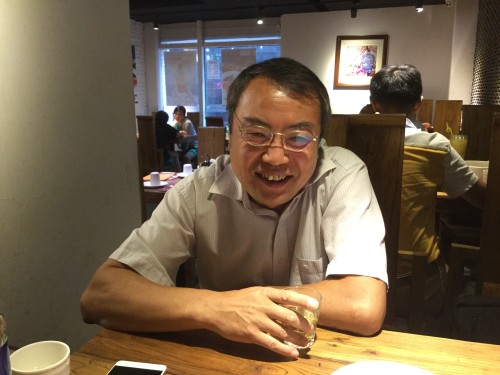
Aiming high: Zhen Cao explains how to use a mountain to detect tau neutrinos.
By Hamish Johnston in Beijing
This evening I had dinner with Zhen Cao, who is one of China’s leading particle astrophysicists and works at the Institute of High Energy Physics of the Chinese Academy of Sciences here in Beijing.
Cao has found a great way to combine his passion for mountains and neutrinos: the Cosmic Ray Tau Neutrino Telescope (CRTNT), which, if built, will use an entire mountain in western China as a cosmic neutrino detector.
The idea is that a high-energy (1016–1017 eV) tau neutrino from space interacts with matter in the mountain to create a tau lepton. If the neutrino is moving horizontally across the mountain, there is a good chance that the tau lepton will come out of the rock and into the air surrounding the mountain. Once out in the open, the tau lepton can collide with an atom in the air to create a shower of particles that can then be detected by Cherenkov telescope detectors located around the mountain.
While the count rate won’t be high – Cao reckons it will be about one event per year – such an experiment would provide important insights into the origins of cosmic neutrinos.
And any old mountain won’t do. Cao told me that the ideal mountain should be very steep and sit within a very flat basin, where the detectors would be located. Cao had worked on cosmic-ray experiments in the western US and initially thought that the mountains surrounding the Great Basin in Nevada might be a good spot.
Then Cao returned to China as part of the “100 Talents” programme and started looking for a mountain closer to home. He consulted his parents (both geographers), spoke to mountain glacier experts and finally spent two weeks in the field in remote western China searching for his ideal peak.
His quest was not in vain because he found the ideal location at Balikun mountain, which is near the city of Hami in the Xinjiang region of China. According to Cao, the mountain rises “like a wall” to 4000 m above sea level and is surrounded by flat plains that stretch out for hundreds of kilometres.
Back in Beijing, Cao has already built two prototype telescopes for the experiment, which will ultimately need 16. Sadly, that’s where the story ends for now because the project is on hold. The problem is money – too much of it. Cao says that China was keen on funding a major neutrino observatory and CRTNT was simply too modest in price.
But don’t feel too sorry for Cao. He is leading the project that got the money – the LHAASO consortium, which is building a huge cosmic ray observatory in Sichuan province in southwest China. You can read more here: Construction starts on huge Chinese cosmic-ray observatory. And in case you are wondering, LHAASO will be located on top of an even higher mountain.
• For more on physics in China, check out our brand new Physics World Special Report: China.
Guidelines
Show/hide formatting guidelines
this text was deletedwhere people live in harmony with nature and animals</q>
Some text